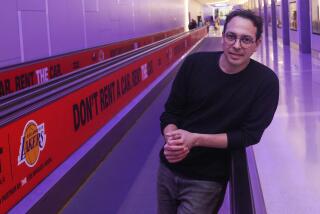He Gives Passengers a Little Flight Music : For Producer Who Puts Together Programs for Airlines, the Sky’s <i> Not </i> the Limit
- Share via
IRVINE — Jokes about plane crashes or airline food are out. Ditto most rap and heavy metal music, though “classic” rock is in and the occasional rap-flavored pop tune squeezes through. New Age music is big, but nothing “too spacey.”
Douglas Boughter admits he has some restrictions on what he can program as executive producer of audio programming for Sony Trans Com, an Irvine-based company that provides in-flight audio entertainment for more than 50 airlines. But the range of material he does work with would give your average radio programmer nightmares, from standard formats including pop, classical and jazz to such esoterica as Cajun music, reggae and a variety of international styles.
Working from an ever-expanding library of more than 5,000 compact discs, Boughter and a full-time engineer shape the programs that airline passengers hear on those little headphones that flight attendants hand out. The choices on most domestic airlines are familiar: a little light jazz to sooth the frazzled nerves of business fliers, a few oldies to tap the memory banks of nostalgic baby boomers.
The job requires some homework. In addition to assembling music programs for international clients (German, French, Chinese and Japanese, among others), Boughter must be prepared to meet offbeat requests from domestic carriers. Once, for instance, a major airline wanted a show featuring music by drum corps.
Drum corps? “They didn’t know much about it, and I knew even less,” Boughter says, so he gave himself a crash course on the subject.
While it could be argued that airlines have the ultimate captive audience--no walkouts here--Boughter says that he can’t afford to think that way. In the highly competitive world of air travel, the quality of the in-flight entertainment is seen as one way to hold on to repeat customers, namely the business traveler.
“It’s not just radio of the air,” says Liliane Aouizerat, manager of audio programming sales. “There’s more to it than putting songs together.”
Most of the programs feature a host who introduces the music, and often there are interviews with the artists. Regular hosts include musician Patrice Rushen on mainstream jazz shows and jazz violinist Doug Cameron for light jazz and New Age. Ami Porat, music director of Orange County’s Mozart Camerata, works on classical music programs.
Record companies often provide canned interviews with artists, but Boughter prefers to get his own, even if it means traveling across the country to get them. He has taped interviews with Wynton Marsalis, Jeffrey Osbourne, James Ingram, Dianne Schuur and New Age artist Ottman Liebert, along with members of Chicago, Styx and the Rippingtons.
Finding appropriate comedy is one of Boughter’s problems.
“It’s so hard to find comedy material for the airlines,” Boughter says. “It can’t be too political. It can’t be too dirty. It certainly can’t have anything about airlines or air travel.”
Boughter tends to rely on some old favorites, such as Bill Cosby and Bob Newhart, but would like to find more up-and-coming young comics whose material would work within the guidelines. “I know they’re out there,” says Boughter, who would like to start taping comics at the Coach House in San Juan Capistrano rather than rely on existing comedy recordings.
One area the company is just getting into is original children’s programming. Working with two of the hottest voice artists in the business--Jody Benson, the voice of “The Little Mermaid,” and Jeff Bergman, who has taken over most of Mel Blanc’s voices for Warner Bros. cartoons--Sony Trans Com has recorded a comic version of “The Ugly Duckling” and plans to work with them on more children’s stories.
There are other spoken programs as well: health talk shows, survival skills for business people and a news/feature program produced with Newsweek magazine.
Most programs last from one to two hours and take two to three months to put together. Each show is unique; different airlines never have the exact same program.
The long lead time means that, for contemporary pop programs, a certain amount of guesswork is involved in predicting what songs will be riding the charts in two months’ time. “You’ve got to be very conscious of the industry charts,” Boughter says.
But the industry charts are little help in programming for overseas airlines, which Boughter does with the help of his own network of foreign contacts. The job has provided some surprises, as when he began working with a Middle East airline.
“They love American pop. They love American jazz,” Boughter says. “Every project is a learning experience, and that’s the exciting part of the job.”
More to Read
Sign up for The Wild
We’ll help you find the best places to hike, bike and run, as well as the perfect silent spots for meditation and yoga.
You may occasionally receive promotional content from the Los Angeles Times.






